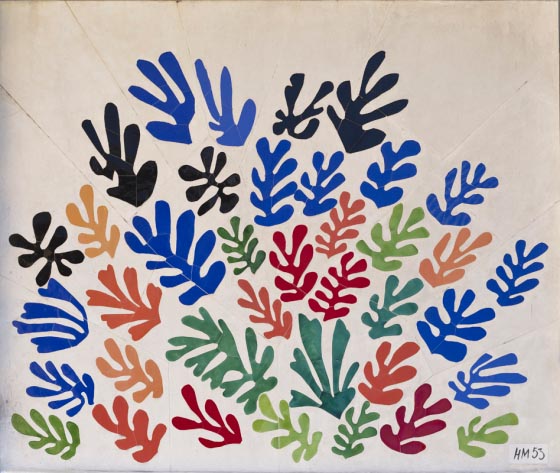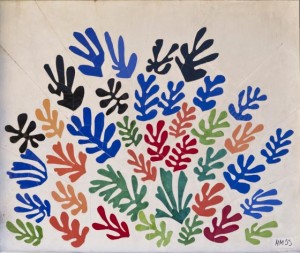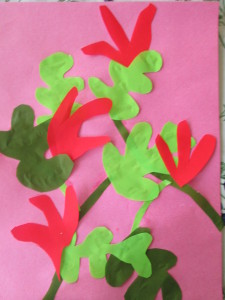Thought: This time around I wanted to get away from paints, pencils, crayons, etc. I also wanted to a closer look at the work of Henri Matisse. (Born in 1869 and died in 1954.) His principal interests were form and color, so he developed a series of colorful paper collages.
Project: We will produce a simple, colorful composition made of cut-out colored paper shapes. This should be appropriate for Grades 1-4. Some K children may have some success with this, but I’ve noticed that more and more children of this age having difficulty using scissors. This project could be easily adapted for an at-home project.
Materials: A background piece of paper. I suggest white paper, but you may decide on something else. It should be something that lets your cut-out shapes stand out. You will also need a selection of brightly colored paper (origami paper works well), scissors, and glue. Glue stick works well, but you may want to find a similar adhesive that can be applied with a smaller tip.
Teacher’s Choice: You may want to think about using complementary colors, or contrasting warm and cool colors in your background and foreground. If you wanted to make it more complicated, the final product could be a three panel composition, each panel showcasing complementary colors.
Management: Distribute scissors and other materials AFTER your slide show and discussion, especially with younger children.
Step 1: Show your students a selection of Matisse’s later paper collage work. Since some of his work is based on nude figures, you’ll have to use some judgement which ones to show. There is one work titled Succession (pictured above) which I used as my inspiration for this project. There are some compositions similar to it that I think children would enjoy seeing.
Step 2: Model lightly drawing a leaf shape on the underside of your colored paper. You may decide to limit colors being used or you may give children several choices as far as shapes. It is extremely important that the children understand not to leave any part of the shape too narrow–so that it becomes difficult to cut, or doesn’t hold together when it’s glued to the background paper.
 Don’t forget! The actual size of the shapes matters a lot. Too small and it’s difficult to cut out and glue. Too large isn’t good either. You want to be able to fit enough pieces on the background paper.
Don’t forget! The actual size of the shapes matters a lot. Too small and it’s difficult to cut out and glue. Too large isn’t good either. You want to be able to fit enough pieces on the background paper.
Step 3: Students should cut their shapes out one at a time and glue them onto their paper, creating an interesting arrangement.
Teacher’s choice: If you want to, have the children to save their cut pieces in a smaller size zip-lock bag, so their pieces don’t end up on the floor, or being accidentally thrown out. This way, children can try arranging all of their shapes BEFORE gluing.
Step 4: Apply the glue. Younger children need to learn the importance of being precise when gluing. A dab in the center of the piece won’t do. The children need to be careful to get the glue around the edges, so that the piece will dry nice and flat. Apply your pieces once you’re sure where you want them to go.
Note: I thought my first version needed a little more zip, so I added some bright red pieces. See what you think.
Step 5: When projects are finished, share them with the rest of the class. During clean-up, try to save as many of the larger paper scraps as you can, rather than throwing them away.
As always, these ideas are just a starting point. They are not full-blown lessons. There is plenty of room for you to adapt these ideas in a way that suits your particular classes. I love hearing from you: feedback, changes, difficulties, etc. Until next time…..
David Cain
(The Green Guy)




Recent Comments